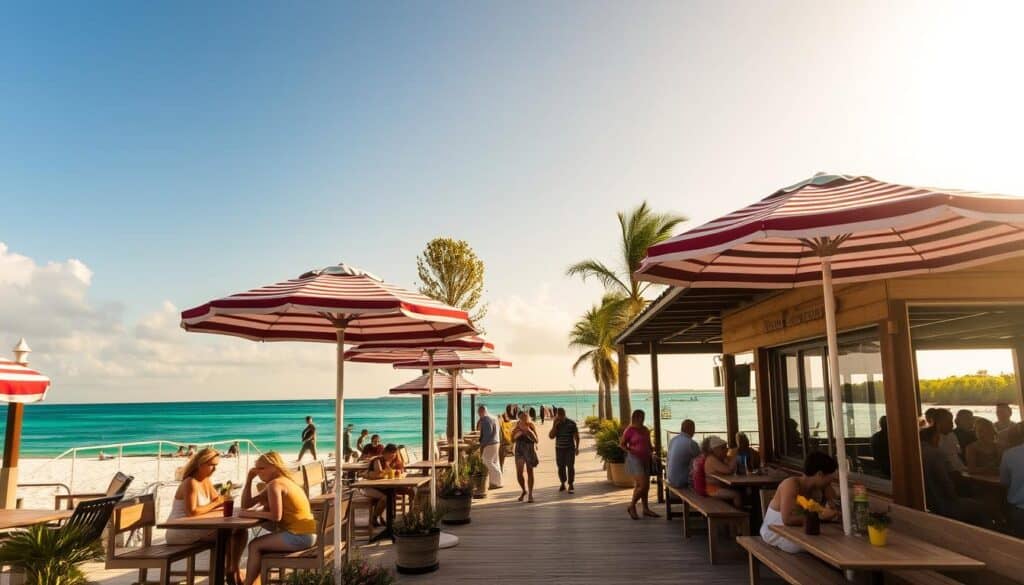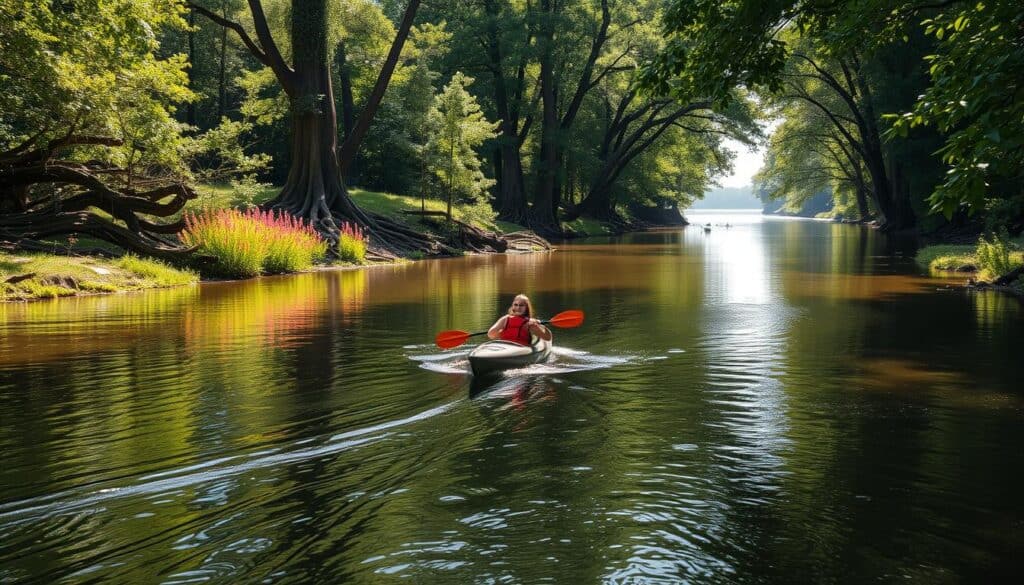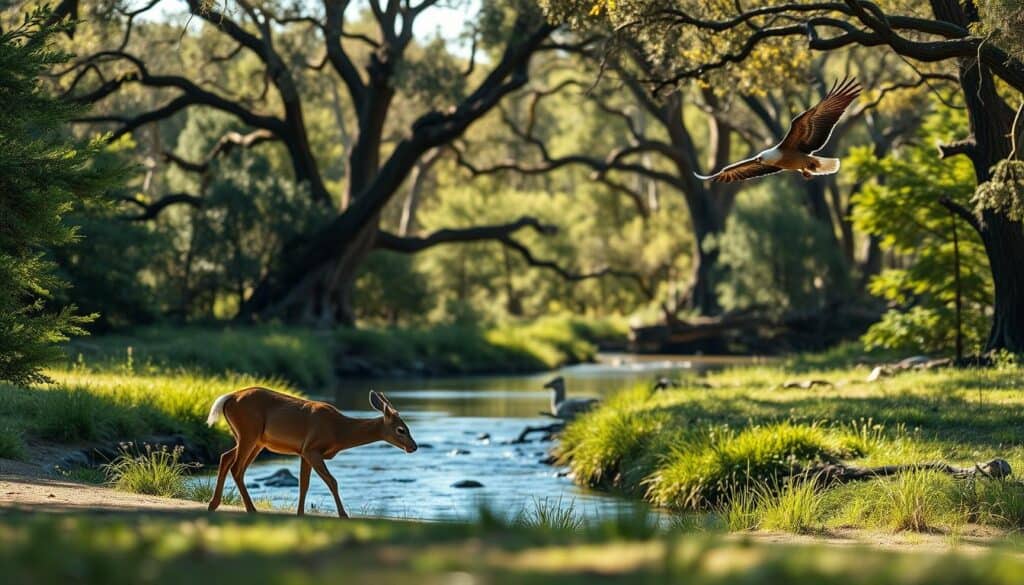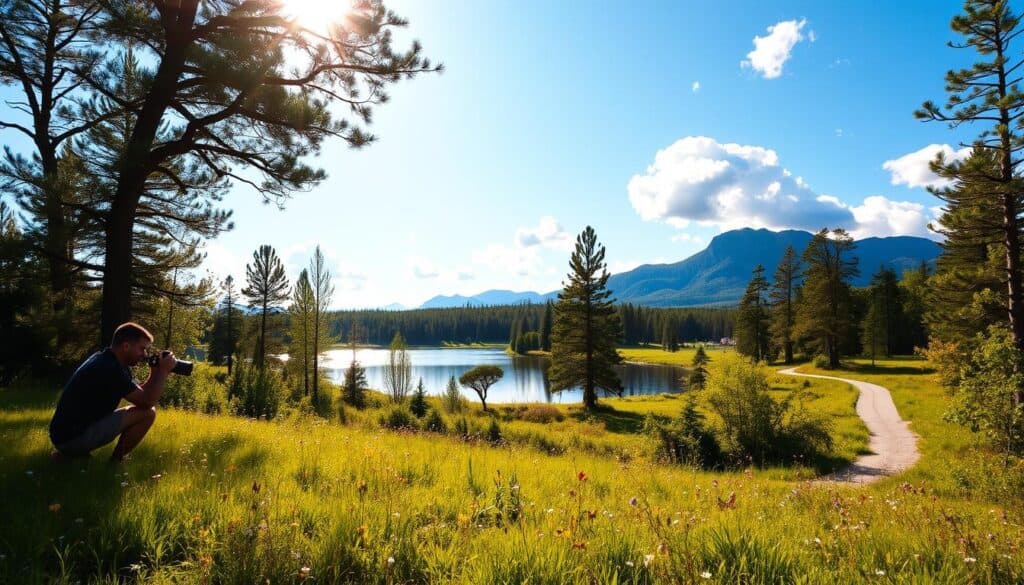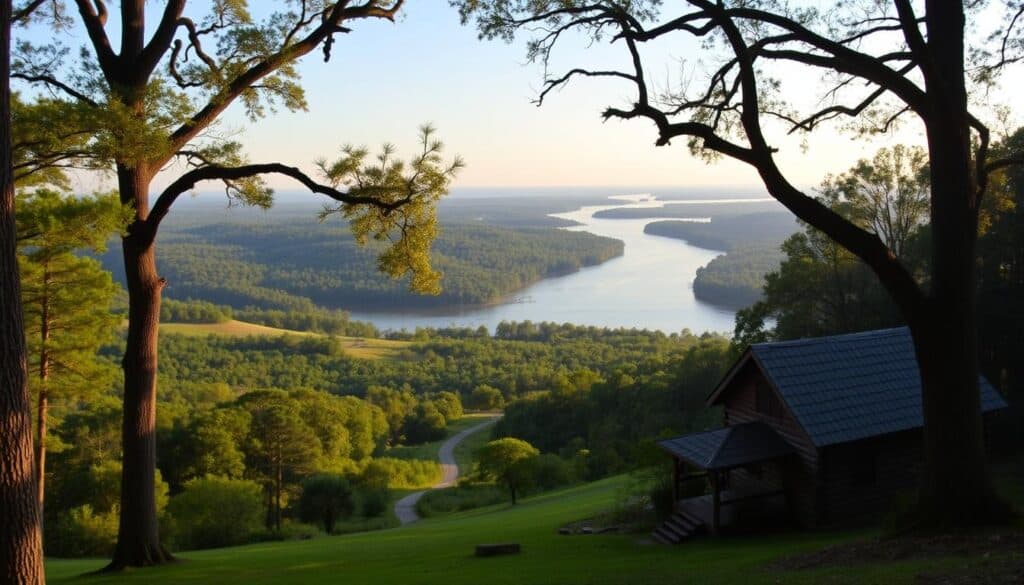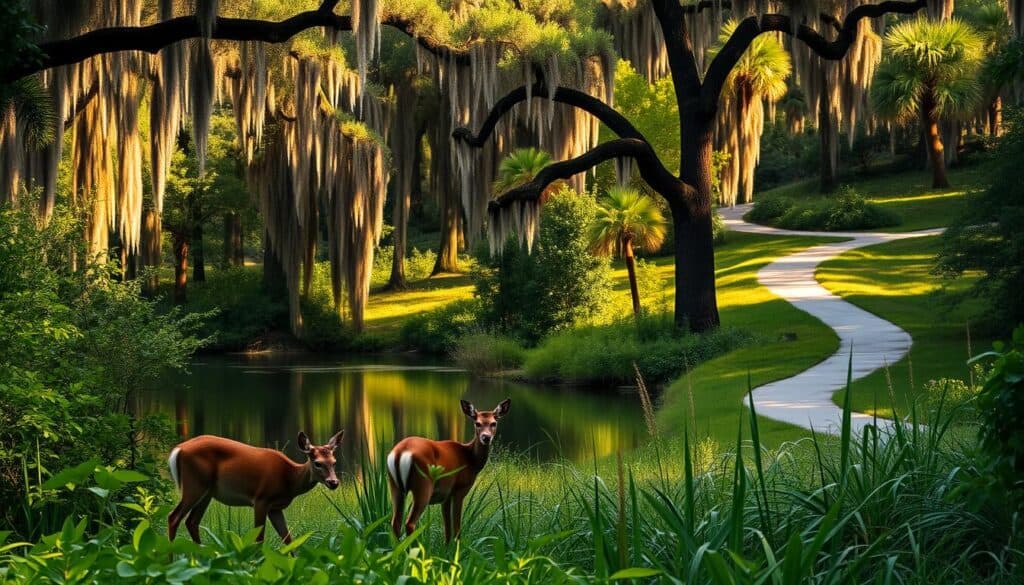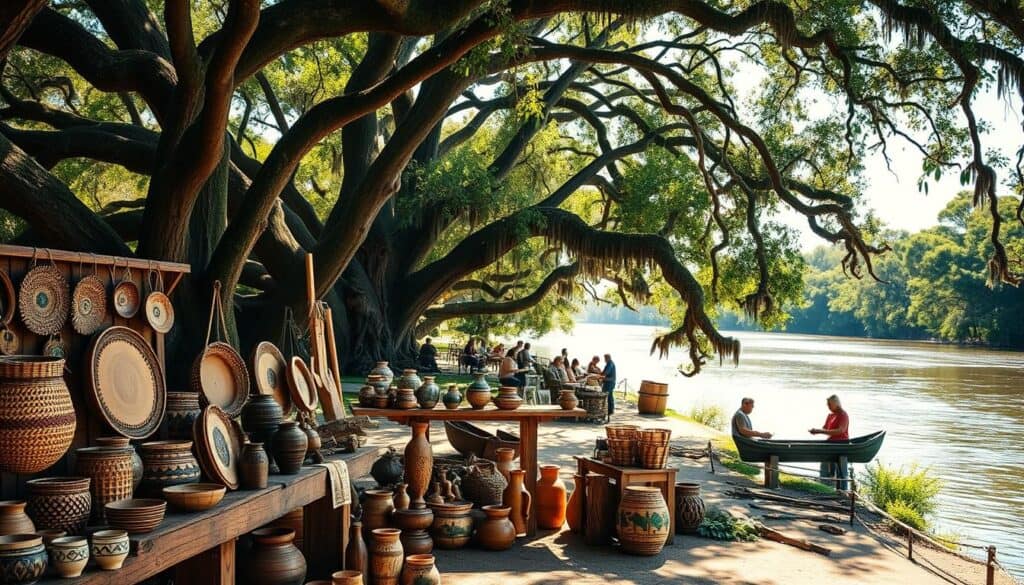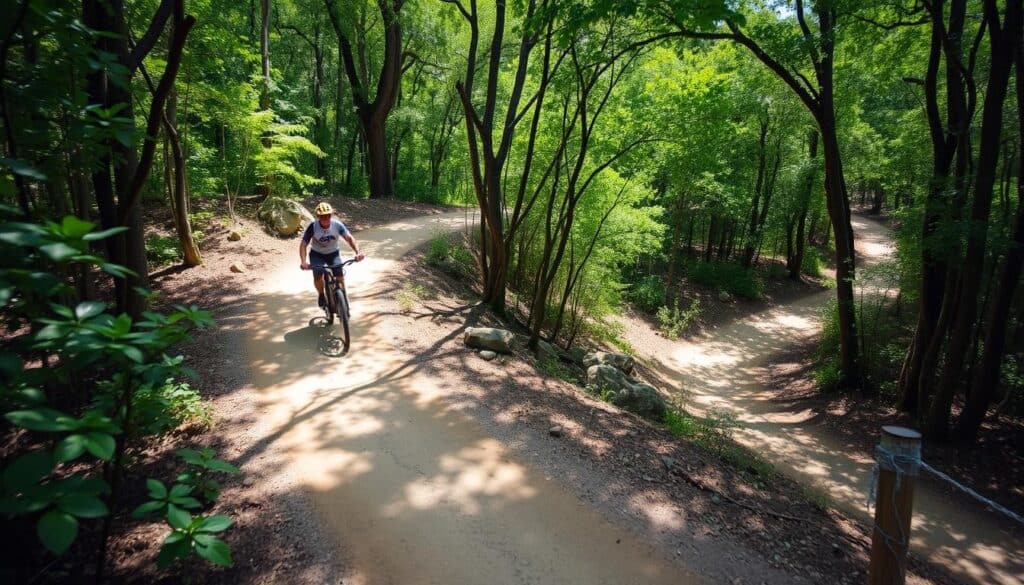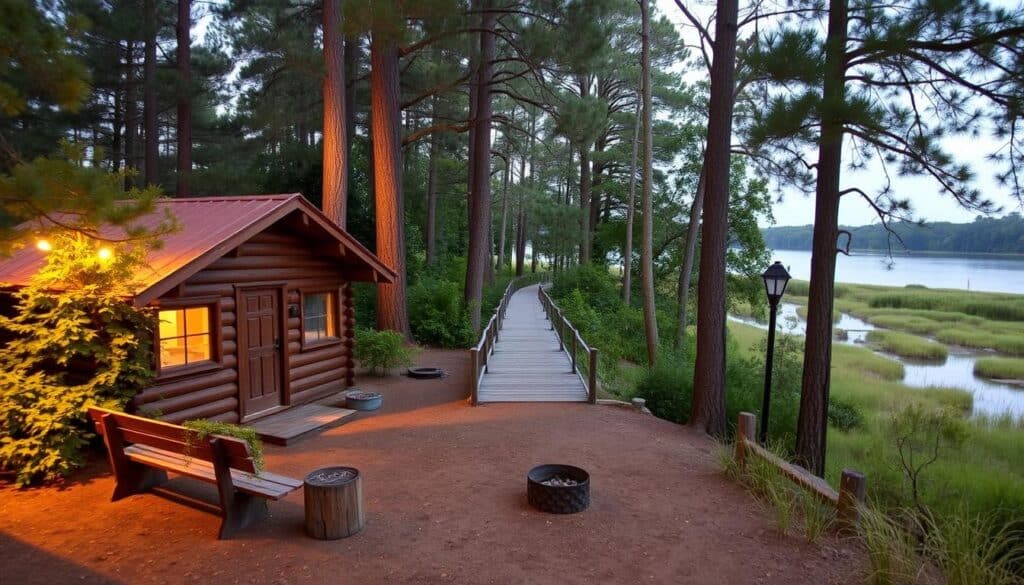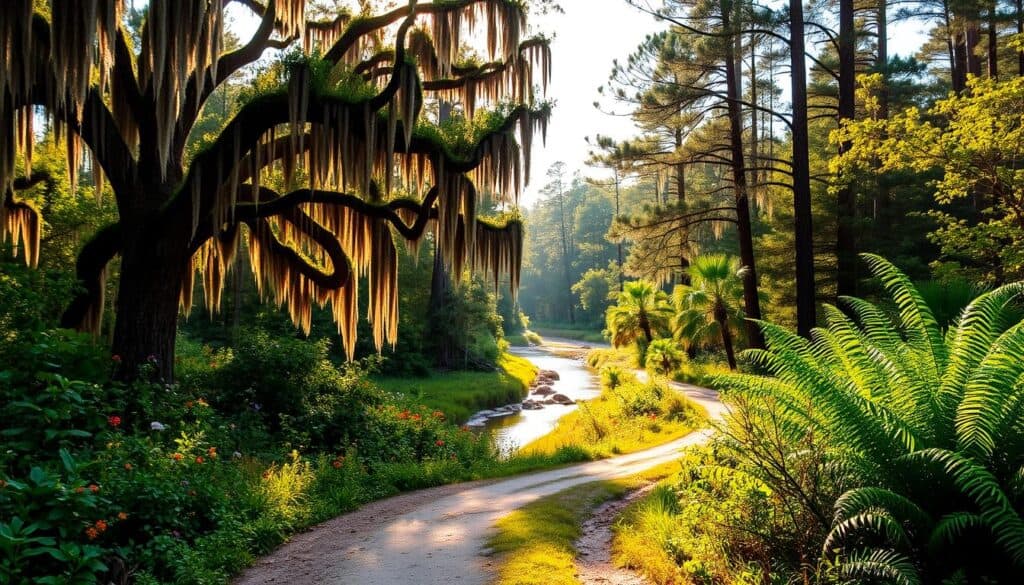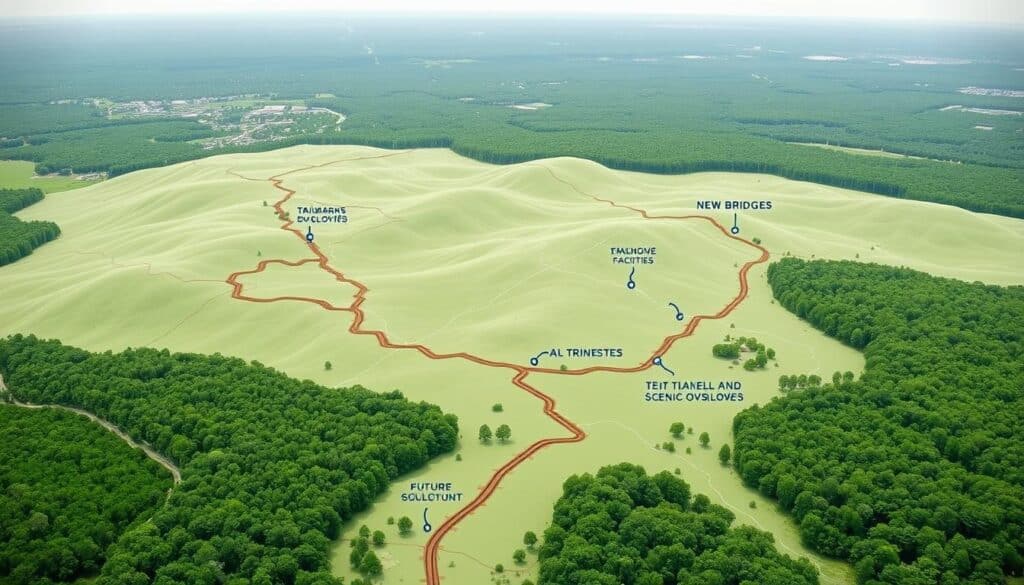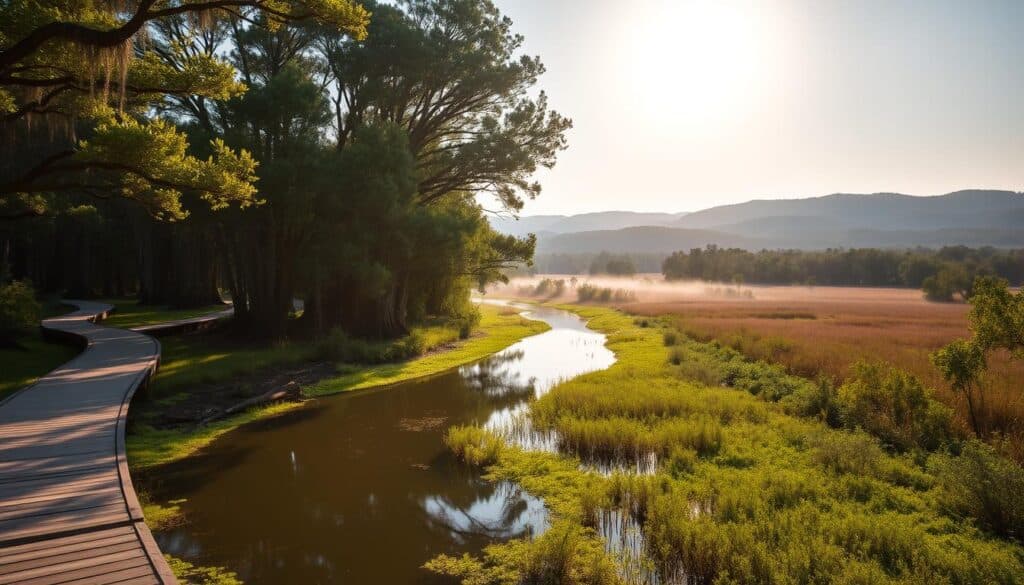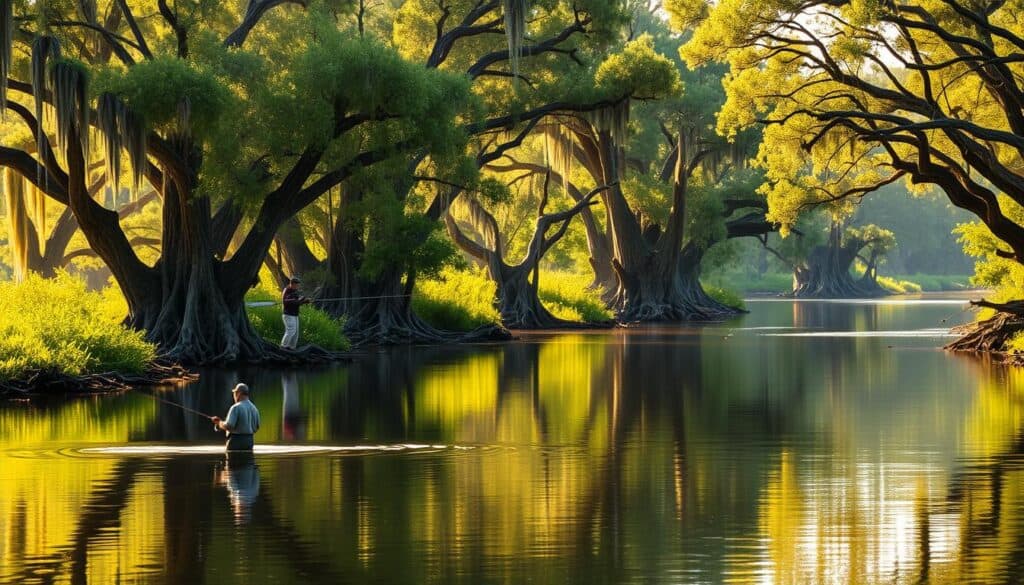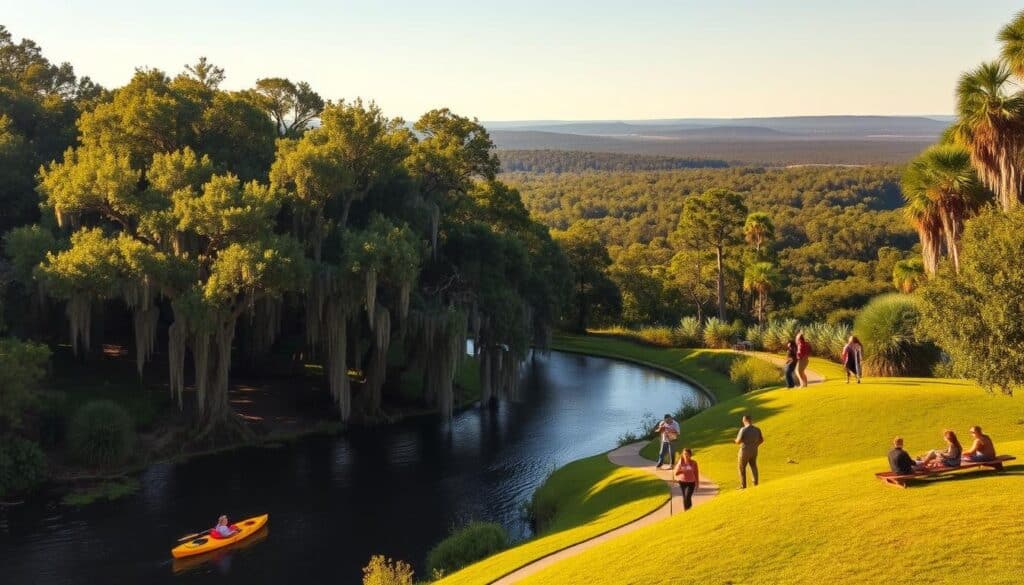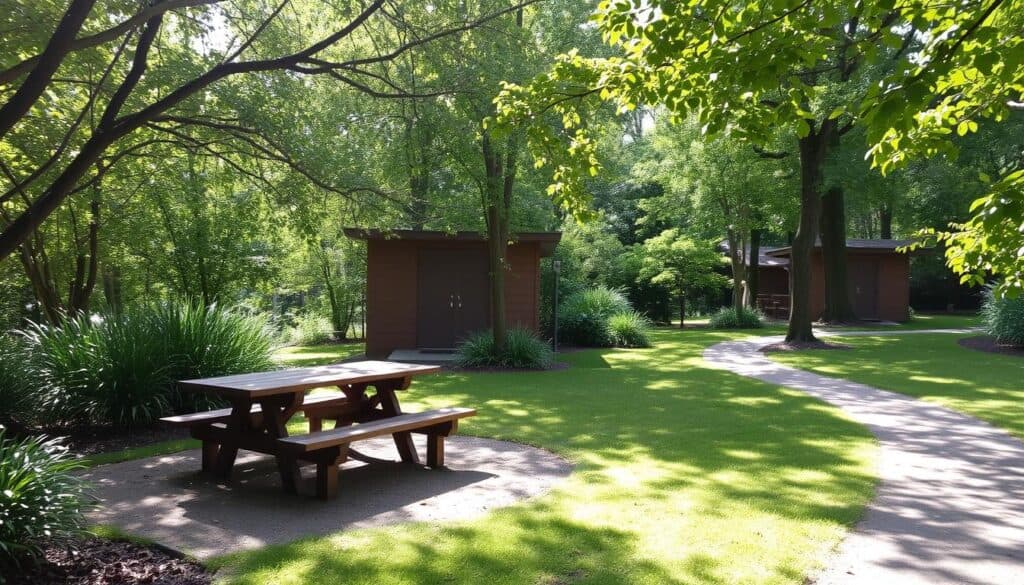The Barnacle Historic State Park, one of Miami’s historic sites, is a must-visit destination for anyone interested in history, nature, and culture. Located on the shore of Biscayne Bay, the park offers a unique glimpse into the past, with its historic house, museum, and beautiful waterfront views. The Barnacle Historic State Park is over 130 years old, founded in 1891, and has been a part of Miami’s history for many years.
Visitors can explore the park’s trails, attend a guided tour, or simply relax in the picnic areas. With its rich history and natural beauty, The Barnacle Historic State Park is an ideal place to spend a day or afternoon, making it one of the top Miami historic sites to visit.
Key Takeaways
- The Barnacle Historic State Park is a historic place to visit on a trip to Coconut Grove.
- The park is open for visitors 6 days a week, from Friday to Wednesday, with admission being $2 per person.
- The Barnacle Historic State Park offers guided tours and various events throughout the year, including the annual Washington’s Birthday Regatta.
- The park has a rich history, with the original homesite being purchased by Ralph Munroe in 1886 for $400.
- The Barnacle Historic State Park is a great place to learn about history, nature, and culture, making it a must-visit destination for anyone interested in Miami historic sites.
- The park provides metered parking and has designated spots for disabled visitors, with public transportation options also available.
- The Barnacle Historic State Park is a unique place to explore, with its historic house, museum, and beautiful waterfront views.
Introduction to The Barnacle Historic State Park
The Barnacle Historic State Park is a hidden gem among Coconut Grove attractions, offering a unique glimpse into the region’s rich history. As one of the most significant Historic landmarks in Miami, the park showcases the importance of preserving our cultural heritage. With its stunning natural surroundings and historic structures, the park is a must-visit destination for anyone interested in exploring the area’s fascinating past.
Established in 1974, the park preserves the historic home of Ralph Munroe, built in 1891. The property spans approximately 5.4 acres and features a unique collection of historical structures, including four historic buildings. Visitors can explore the park’s grounds, which include a variety of plant and animal species, and enjoy the beautiful views of Biscayne Bay.
A Brief Overview of the Park’s History
The park’s history dates back to the late 19th century, when Ralph Munroe, a pioneer and sailor, settled in Coconut Grove. The house, which is now a museum, offers a glimpse into the life of Munroe and his family, and showcases the significance of historical preservation. With over 40,000 visitors annually, the park is a popular destination for those interested in learning about the region’s history and culture.
Importance of Historical Preservation
The Barnacle Historic State Park is a testament to the importance of preserving our cultural heritage. By protecting and preserving historic landmarks like the park, we can ensure that future generations can learn from and appreciate the region’s rich history. The park’s preservation efforts are a significant part of its mission, and visitors can learn about the importance of historical preservation through guided tours and educational programs.
| Year | Event | Description |
|---|---|---|
| 1886 | Initial purchase | Ralph Munroe purchases 40 acres of land for $400 |
| 1891 | Construction of The Barnacle | Ralph Munroe builds his historic home, The Barnacle |
| 1974 | Establishment of the park | The Barnacle Historic State Park is established to preserve the historic home and surrounding grounds |
Location and Accessibility
Located in the heart of Coconut Grove, The Barnacle Historic State Park is one of the most accessible Florida state parks in the region. Visitors can easily reach the park by car or public transportation, making it an ideal destination for families and individuals alike. With its rich history and natural beauty, The Barnacle Historic State Park is a must-visit attraction in South Florida.
The park is open Friday through Wednesday from 9 a.m. to 5 p.m., allowing visitors to plan their trip according to their schedule. With an admission fee of just $2 per person, it’s an affordable outing for the whole family. Children aged 5 and under enter for free, making it an excellent option for families with young children. The park is closed on Thursdays, Christmas Day, and New Year’s Day, so be sure to plan your visit accordingly.
How to Get There
Getting to The Barnacle Historic State Park is easy, with several public transportation options available. Visitors can take buses #22 & #42 from Douglas Metrorail Station, Bus #27 from Coconut Grove Metrorail Station, or Bus #48 from Government Center and Douglas Metrorail Stations. For those driving, metered parking options are available across the street and curbside throughout the neighborhood. Designated disabled parking spots are also available on-site, ensuring that the park is accessible to all visitors.
Visitor Information and Amenities
Once you arrive at The Barnacle Historic State Park, you’ll find a range of amenities to enhance your visit. The park offers guided tours of The Munroe House Museum at 10 a.m., 11:30 a.m., 1 p.m., and 2:30 p.m. on Saturday through Wednesday. With its stunning natural beauty and rich history, The Barnacle Historic State Park is the perfect destination for anyone looking to explore the best of Florida state parks. Whether you’re interested in history, nature, or simply looking for a fun day out, The Barnacle Historic State Park has something for everyone.
The Barnacle House
The Barnacle House, located in Historic landmarks in Miami, is a stunning example of late 19th-century architecture. Built in 1891 by Ralph Middleton Munroe, the house is the oldest in Miami-Dade County still standing in its original location. As part of The Barnacle Historic State Park, the house offers a glimpse into the history of Coconut Grove and the life of the Munroe family.
Some key features of the house include:
- Unique design inspired by boat construction and traditional Caribbean homes
- Beautiful surroundings, showcasing the natural beauty of the area
- Preserved to reflect the life and times of the Munroe family
Visitors can take a guided tour of the house and learn more about its architectural significance and the family’s legacy. With its rich history and stunning architecture, The Barnacle House is a must-visit destination for anyone interested in Historic landmarks in Miami and The Barnacle Historic State Park.
| Feature | Description |
|---|---|
| Year Built | 1891 |
| Architect | Ralph Middleton Munroe |
| Location | Coconut Grove, Miami-Dade County |
Guided Tours and Visitor Programs
The Barnacle Historic State Park offers a range of guided tours and visitor programs that cater to different interests and ages. Visitors can take a guided tour of The Munroe House Museum, which offers a glimpse into the life and times of the Munroe family. The park also offers educational workshops and events, such as yoga classes, concerts, and festivals, which provide a unique and engaging experience for visitors.
Guided tours of The Munroe House Museum are offered Saturday through Wednesday at 10 a.m., 11:30 a.m., 1 p.m., and 2:30 p.m. The park is open 6 days a week, from 9 a.m. to 5 p.m., and is closed on Thursdays, Christmas Day, and New Year’s Day. Admission fee is $2 per person, and children ages 5 and under are free.
Some of the highlights of the guided tours and visitor programs at The Barnacle Historic State Park include:
- Guided tours of The Munroe House Museum
- Yoga classes and other educational workshops
- Concerts and festivals
- Special events, such as a chili cook-off and movie screenings under the stars
Whether you’re interested in history, nature, or culture, there’s something for everyone at The Barnacle Historic State Park, one of the most unique Miami historic sites. The park’s location in Coconut Grove, with its artistic vibe and bohemian charm, adds to its appeal. So why not plan a visit to The Barnacle Historic State Park and experience all that it has to offer?

| Day | Time | Tour |
|---|---|---|
| Saturday | 10 a.m. | Guided tour of The Munroe House Museum |
| Saturday | 11:30 a.m. | Guided tour of The Munroe House Museum |
| Saturday | 1 p.m. | Guided tour of The Munroe House Museum |
| Saturday | 2:30 p.m. | Guided tour of The Munroe House Museum |
Nature and Wildlife
The Barnacle Historic State Park is a haven for nature lovers and those seeking to explore the diverse ecosystems of Florida state parks. Located near Coconut Grove attractions, the park offers a unique opportunity to experience the natural beauty of South Florida.
The park is home to a variety of ecosystems, including mangrove forests, coral reefs, and sea grass beds, which provide a habitat for a wide range of marine life. Visitors can explore the park’s trails and enjoy the beautiful scenery, or take a guided tour to learn more about the park’s ecosystems and wildlife.
One of the highlights of the park is its birdwatching opportunities, with over 100 species of birds documented in the area. The park’s diverse ecosystems and location near Coconut Grove attractions make it an ideal spot for nature enthusiasts and those looking to experience the best of Florida state parks.
Some of the key features of the park’s ecosystems include:
- Mangrove forests, which provide a habitat for a variety of marine life
- Coral reefs, which are home to a diverse range of fish and other marine species
- Sea grass beds, which provide a habitat for sea turtles and other marine animals
Recreational Activities
The Barnacle Historic State Park offers a variety of recreational activities for visitors to enjoy. Located in the heart of Miami, this historic landmark is a must-visit destination for outdoor enthusiasts and history buffs alike. With its stunning natural beauty and rich cultural heritage, The Barnacle Historic State Park is an ideal spot for those looking to explore Historic landmarks in Miami.
Visitors can hike or walk along the park’s trails, including the popular Old Cutler Trail, which offers breathtaking views of the surrounding landscape. The park also features several picnicking areas, perfect for relaxing and taking in the scenery. Whether you’re looking for adventure or just want to unwind, The Barnacle Historic State Park has something for everyone.
Hiking and Walking Trails
The park’s trails are well-marked and well-maintained, making it easy for visitors to navigate and explore the area. The Old Cutler Trail is a favorite among visitors, offering stunning views of the surrounding landscape and a glimpse into the area’s rich history.
Picnicking Areas
The park’s picnicking areas are equipped with tables, grills, and restrooms, making it easy for visitors to enjoy a meal or snack in the great outdoors. With its beautiful scenery and tranquil atmosphere, The Barnacle Historic State Park is the perfect spot to relax and enjoy quality time with family and friends.
As one of the most popular Historic landmarks in Miami, The Barnacle Historic State Park is a must-visit destination for anyone looking to explore the area’s rich history and natural beauty. With its variety of recreational activities and stunning scenery, this park is sure to delight visitors of all ages.
Events and Celebrations
The Barnacle Historic State Park is a popular venue for events and celebrations in Coconut Grove, offering a unique blend of natural beauty and historic charm. As one of the top Coconut Grove attractions, the park hosts several events throughout the year, including the annual Barnacle Under Moonlight Concert, which features live music and stunning views of the bay.
Among the Florida state parks, The Barnacle Historic State Park stands out for its diverse range of events and activities. Some of the special events and themed days include festivals, reenactments, and community gatherings, which provide a unique and engaging experience for visitors. Whether you’re looking for entertainment or just want to learn something new, The Barnacle Historic State Park has something for everyone.
Some of the upcoming events at the park include the Barnacle Under Moonlight Concert featuring Keith Johns, scheduled for February 14, 2025, and the Washington’s Birthday Regatta, a maritime tradition that has been celebrated since 1887. The park also offers several community events and programs throughout the year, including yoga classes and seasonal events such as chili cook-offs.
With its rich history and natural beauty, The Barnacle Historic State Park is an ideal destination for those looking to experience the best of Coconut Grove attractions and Florida state parks. So why not plan your visit today and join in on the fun?
The Role of Volunteers
The Barnacle Historic State Park relies on volunteers to help with its operations and events, offering a range of opportunities for community involvement. Volunteers can assist with tasks such as gardening, maintenance, and event planning, and also participate in educational programs and workshops.
Volunteering at The Barnacle Historic State Park provides numerous benefits, including the chance to meet new people, learn new skills, and contribute to the preservation of a historic landmark in Miami historic sites. With over 14,400 state park volunteers involved across Florida, including those at The Barnacle Historic State Park, the impact of volunteer work is significant.
Some examples of volunteer contributions include:
- Participating in the Second Saturday Monthly Beach Cleanup, which has grown from 10 to over 200 participants
- Assisting with educational programs and workshops, such as the citizen science marine debris program
- Helping with park maintenance and upkeep, including the care of the park’s 28-foot Sharpie replica sailboat

By volunteering at The Barnacle Historic State Park, individuals can make a meaningful difference in the preservation of this Miami historic site, while also gaining valuable experience and connections within the community.
Conservation Efforts
The Barnacle Historic State Park is committed to conservation and preservation, with a range of efforts underway to protect its historic buildings and natural habitats. As one of the many Florida state parks, it plays a vital role in preserving the state’s natural and cultural heritage. Located near Historic landmarks in Miami, the park is a popular destination for those interested in history, nature, and culture.
Some of the conservation efforts include the restoration of mangrove forests and the protection of sea grass beds. The park also undertakes historical site maintenance, including the preservation of its historic buildings and the conservation of its artifacts. The following are some of the key conservation efforts:
- Restoration of mangrove forests
- Protection of sea grass beds
- Historical site maintenance
- Conservation of artifacts
These efforts are crucial in maintaining the park’s biodiversity and preserving its natural and cultural resources for future generations. By visiting The Barnacle Historic State Park, you are supporting the conservation of Florida state parks and the preservation of Historic landmarks in Miami.
| Conservation Effort | Description |
|---|---|
| Restoration of mangrove forests | Restoring mangrove forests to their natural state |
| Protection of sea grass beds | Protecting sea grass beds from damage and degradation |
| Historical site maintenance | Maintaining the park’s historic buildings and artifacts |
Visitor Experience and Reviews
The Barnacle Historic State Park is a beloved destination in Coconut Grove, attracting visitors from around the world. With its rich history, stunning natural beauty, and friendly staff, it’s no wonder that guests have praised the park for its unique and engaging experience.
Visitors have appreciated the park’s guided tours, which provide a deeper understanding of the park’s history and significance. The park’s picnic areas and recreational activities have also been a hit with guests, offering a chance to relax and enjoy the beautiful surroundings. For first-time guests, the park offers a range of tips and recommendations, including the best times to visit and the most popular activities to enjoy.
Some of the key features that make The Barnacle Historic State Park a must-visit destination in Coconut Grove include:
- Beautiful scenery and historic charm
- Guided tours and interactive exhibits
- Picnic areas and recreational activities
- Friendly and knowledgeable staff
Whether you’re a seasoned traveler or just looking for a new adventure, The Barnacle Historic State Park has something for everyone. With its rich history, stunning natural beauty, and friendly staff, it’s the perfect destination for anyone looking to experience the best of Coconut Grove attractions.
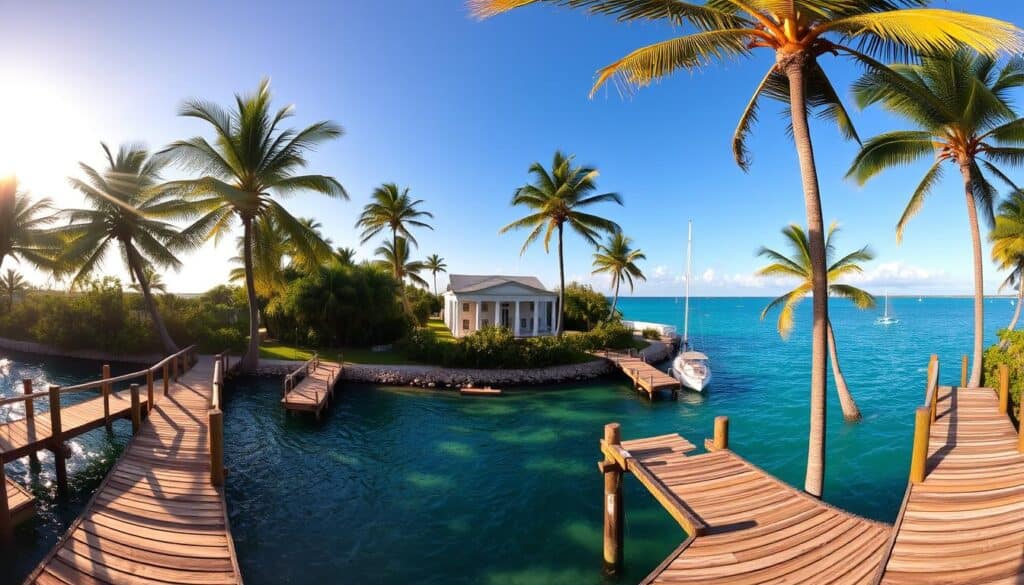
So why not plan your visit today and discover the magic of The Barnacle Historic State Park for yourself?
| Feature | Description |
|---|---|
| Guided Tours | Available Saturday through Wednesday at 10 a.m., 11:30 a.m., 1 p.m., and 2:30 p.m. |
| Picnic Areas | Available throughout the park, perfect for relaxing and enjoying the scenery |
| Recreational Activities | Varying activities available, including hiking and walking trails |
Nearby Attractions
Visitors to The Barnacle Historic State Park are spoiled for choice when it comes to exploring the surrounding area. The park is nestled near several Miami historic sites, including the Vizcaya Museum and Gardens and the Miami Seaquarium. These attractions offer a glimpse into the region’s rich history and natural beauty, making them perfect for those interested in Florida state parks and beyond.
For those looking to experience the local culture, the nearby town of Coconut Grove is a must-visit. With its range of shops, restaurants, and cultural attractions, there’s something for everyone to enjoy. The park’s staff is happy to provide recommendations and advice on the best places to visit and things to do in the area.
Some popular activities in the area include kayaking and paddleboarding through the mangrove trails, showcasing Coconut Grove’s natural attractions. The town also hosts a weekly Farmer’s Market, promoting fresh and locally-sourced produce. With its diverse array of shopping, dining, and entertainment options, Coconut Grove is the perfect destination for those looking to experience the best of Miami historic sites and Florida state parks.
The Park’s Cultural Significance
The Barnacle Historic State Park is a significant cultural and historical landmark in Florida, playing an important role in the state’s identity. As one of the historic landmarks in Miami, it provides a glimpse into the life and times of the Munroe family, offering a unique perspective on the state’s history.
Located in Coconut Grove, The Barnacle Historic State Park is recognized as the oldest house in Miami-Dade County still standing in its original location. This distinction highlights its importance as a historic landmark in the area. Some of the key features and nearby attractions that contribute to its cultural significance include:
- Guided walking tours available in Coconut Grove, providing insights into the area’s architectural history and cultural heritage
- Peacock Park, named after Charles and Isabella Peacock, early settlers, showcasing the historical figures that shaped Coconut Grove’s community identity
- The E.W.F. Stirrup House, serving as a significant architectural reminder of African American history in Coconut Grove
As a testament to its cultural significance, The Barnacle Historic State Park is a must-visit destination for anyone interested in history, culture, or nature. With its rich history and stunning natural surroundings, it is an ideal place to explore and learn about the historic landmarks in Miami and their importance in shaping the community’s identity.
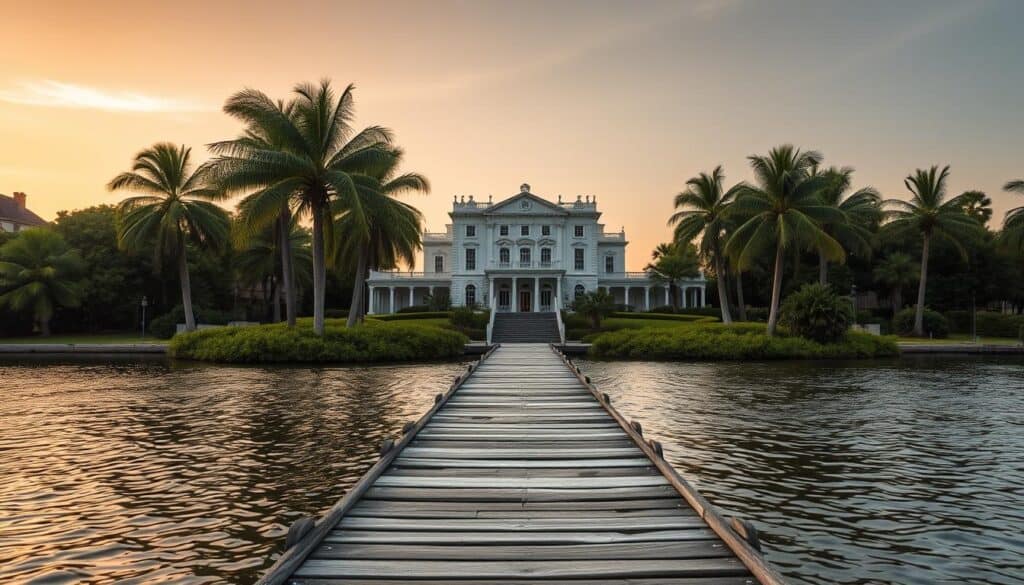
By visiting The Barnacle Historic State Park, visitors can gain a deeper understanding of the area’s history and cultural heritage, making it an essential part of any trip to Miami. Whether you’re interested in exploring the historic landmarks in Miami or simply want to experience the natural beauty of the area, The Barnacle Historic State Park is a destination that has something for everyone.
| Landmark | Location | Significance |
|---|---|---|
| The Barnacle Historic State Park | Coconut Grove | Oldest house in Miami-Dade County still standing in its original location |
| Peacock Park | Coconut Grove | Named after Charles and Isabella Peacock, early settlers |
| The E.W.F. Stirrup House | Coconut Grove | Significant architectural reminder of African American history in Coconut Grove |
Future Developments and Enhancements
The Barnacle Historic State Park is constantly evolving and improving, with several future developments and enhancements planned. Visitors can look forward to new and improved facilities, including picnic areas and hiking trails, as well as new events and celebrations.
Some of the planned improvements include the restoration of historic buildings and the expansion of recreational activities. The park is also considering managing public access by shuttling small groups of visitors from The Barnacle Historic State Park to limit traffic congestion.
As one of the top Coconut Grove attractions, The Barnacle Historic State Park is committed to providing a unique and enjoyable experience for its visitors. With its rich history and natural beauty, the park is a must-visit destination for anyone interested in exploring the best of Florida’s outdoor attractions.
Here are some of the upcoming projects and expansions planned for The Barnacle Historic State Park:
- Restoration of historic buildings
- Expansion of recreational activities
- Improvement of picnic areas and hiking trails
- New events and celebrations
With its future developments and enhancements, The Barnacle Historic State Park is sure to remain one of the top Coconut Grove attractions for years to come.
| Project | Description | Status |
|---|---|---|
| Restoration of historic buildings | Restoring the park’s historic buildings to their original condition | In progress |
| Expansion of recreational activities | Adding new recreational activities, such as hiking trails and picnic areas | Planned |
| Improvement of picnic areas and hiking trails | Improving the park’s picnic areas and hiking trails to enhance the visitor experience | In progress |
Conclusion: A Treasure Waiting to Be Explored
As we conclude our journey through the The Barnacle Historic State Park, it’s clear that this Miami landmark is a true treasure waiting to be explored. With its rich history, beautiful natural surroundings, and array of engaging activities, the park offers something for visitors of all interests. Whether you’re drawn to the architectural significance of the historic Barnacle House, the diverse ecosystems and wildlife, or the chance to immerse yourself in the cultural heritage of the region, this state park is a must-visit destination.
The Barnacle Historic State Park serves as a testament to Miami’s past, preserving the stories and traditions that have shaped the city. As you wander through the grounds, you’ll feel a deep connection to the early pioneers and settlers who once called this place home. The park’s commitment to conservation and historical preservation ensures that these stories will continue to be shared for generations to come.
So why not plan your visit to the Barnacle Historic State Park today? Discover the hidden gems, explore the captivating history, and immerse yourself in the natural beauty that this remarkable destination has to offer. Whether you’re a local or a visitor, this Miami historic site is sure to leave a lasting impression and inspire a new appreciation for the city’s rich cultural heritage.
FAQ
What is the Barnacle Historic State Park?
The Barnacle Historic State Park is a must-visit destination in Miami, Florida that offers a unique glimpse into the past. The park features a historic house, museum, and beautiful waterfront views, providing visitors with the opportunity to explore the area’s rich history and natural beauty.
What is the history of the Barnacle Historic State Park?
The Barnacle Historic State Park was built in 1891 by Ralph Middleton Munroe, a pioneer and sailor who settled in Coconut Grove. The historic house, which is now a museum, showcases the importance of historical preservation and the legacy of the Munroe family.
How can I access the Barnacle Historic State Park?
The Barnacle Historic State Park is easily accessible by car, public transportation, bike, or on foot. The park has designated parking areas, and is open Friday through Wednesday from 9 a.m. to 5 p.m., with restrooms and picnic areas available for visitors.
What can I see and do at the Barnacle Historic State Park?
Visitors can explore the Munroe House Museum, take guided tours, attend educational workshops and events, enjoy the park’s nature trails and wildlife, and participate in a range of recreational activities such as hiking, walking, and picnicking.
Does the Barnacle Historic State Park host any special events?
Yes, the park hosts a variety of events throughout the year, including the annual Barnacle Under Moonlight Concert, festivals, and reenactments, providing unique and engaging experiences for visitors.
How can I get involved with the Barnacle Historic State Park?
The Barnacle Historic State Park relies on volunteers to help with its operations and events, offering a range of opportunities for community involvement, including gardening, maintenance, and educational programs.
What is the Barnacle Historic State Park’s commitment to conservation and preservation?
The park is actively involved in ecological preservation projects, such as the restoration of its mangrove forests and the protection of its sea grass beds, as well as historical site maintenance to preserve its historic buildings and artifacts.
What is the visitor experience like at the Barnacle Historic State Park?
Visitors have praised the park’s guided tours, beautiful scenery, and friendly staff, and have also appreciated the range of activities and amenities available. The park offers tips and recommendations for first-time guests to help them make the most of their visit.
What other attractions are near the Barnacle Historic State Park?
The Barnacle Historic State Park is located near other popular attractions, such as the Vizcaya Museum and Gardens and the Miami Seaquarium, as well as the nearby town of Coconut Grove, which offers a range of shops, restaurants, and cultural attractions.
Why is the Barnacle Historic State Park significant for Florida’s history and identity?
The Barnacle Historic State Park is a significant cultural and historical landmark in Florida, providing a unique perspective on the state’s history and playing an important role in the local community’s identity.
What future developments and enhancements are planned for the Barnacle Historic State Park?
The park is constantly evolving and improving, with a range of projects planned, including the restoration of historic buildings, the expansion of recreational activities, and the addition of new events and celebrations, ensuring that there will always be something new to discover.



